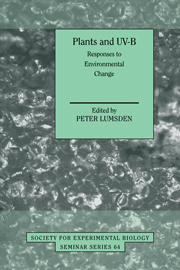Book contents
- Frontmatter
- Contents
- List of contributors
- Preface
- PART I The ozone layer and UV-B radiation
- PART II Effects of UV-B on plants at the cellular level
- PART III Effects of UV-B at the whole plant and community level
- Effects of solar UV-B radiation on aquatic ecosystems
- Assessing the impact of UV-B radiation on the growth and yield of field crops
- Effects of UV-B radiation on plants from agro- and natural ecosystems
- Effects on subarctic vegetation of enhanced UV-B radiation
- Impacts of elevated UV-B on forest ecosystems
- Effects of elevated UV-B radiation and elevated CO2 on heathland communities
- Alterations in competitive balance
- Interations between trophic levels
- Index
Effects of solar UV-B radiation on aquatic ecosystems
Published online by Cambridge University Press: 04 August 2010
- Frontmatter
- Contents
- List of contributors
- Preface
- PART I The ozone layer and UV-B radiation
- PART II Effects of UV-B on plants at the cellular level
- PART III Effects of UV-B at the whole plant and community level
- Effects of solar UV-B radiation on aquatic ecosystems
- Assessing the impact of UV-B radiation on the growth and yield of field crops
- Effects of UV-B radiation on plants from agro- and natural ecosystems
- Effects on subarctic vegetation of enhanced UV-B radiation
- Impacts of elevated UV-B on forest ecosystems
- Effects of elevated UV-B radiation and elevated CO2 on heathland communities
- Alterations in competitive balance
- Interations between trophic levels
- Index
Summary
Introduction
Ozone depletion caused by the production and release of anthropogenic trace gases has been documented to be responsible for the increase of solar ultraviolet radiation in the UV-B wavelength range (280–320 nm) over polar and mid-latitudes, while in the tropics little or no increase has been measured (Rowland, 1989; Wei, 1991). Due to the long half-lives of the chlorinated fluorocarbons (CFCs) and the fact that their production and emission will only be gradually phased out, it is likely that the peak of ozone depletion is still to come. The current predictions envisage a peak of ozone depletion around the year 2000; decreased ozone values and increased solar UV-B radiation will therefore be with us well through the next century (Madronich et al., 1995). In addition to the Antarctic ozone hole, abnormal high chlorine concentrations and concomitant decreases in the ozone layer have been found over the Northern Hemisphere (Madronich et al., 1995; Blumthaler & Ambach, 1990). The resulting increased solar UV-B radiation has been suspected to affect aquatic eco-systems which are responsible for half of the biomass production of the planet. In order to determine whether or not aquatic eco-systems are at risk, a number of key questions need to be investigated.
What is the penetration of solar UV radiation into the water column?
What is the vertical distribution of ecologically major biomass producers?
What is the biological sensitivity of aquatic organisms?
[…]
- Type
- Chapter
- Information
- Plants and UV-BResponses to Environmental Change, pp. 171 - 194Publisher: Cambridge University PressPrint publication year: 1997
- 5
- Cited by



